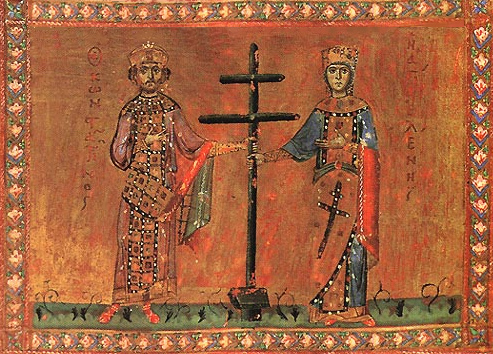Daily Office Readings for the feast of Helena of Constantinople, May 22, 2020:
Helena of Constantinople is another of those folks on our calendar that’s hard to tease out the facts from the legends, but when we do, we still see a woman of strength who was very devoted to her son. It’s easy to simply dismiss her as Constantine’s mother, but she was far more than that.
Helena was probably a native Greek, born in Drepana, in the province of Bithynia, in Asia Minor, sometime between the years 246 to 248. Although there’s a popular legend that she was the princess daughter of “Old King Cole” (Welsh king Coel Hen), there’s probably no basis in the fanciful connection of a 3rd century king to an 18th century nursery rhyme. More likely, we can trust Ambrose of Milan’s mention that she was either an innkeeper or a stable-maid (depending on how you translate the word he uses, stabularia.)
We know virtually nothing of her childhood or young adulthood except that she ended up being paired in some kind of situation we’d loosely call “wedlock” (it’s unclear whether they were married, or it was a common law marriage, or she was part of a concubine) with Constantius, the father of Constantine. Constantine was born of this union sometime around 270; subsequently, we also know that Constantius divorced her in some manner prior to 289, because that is when Constantius married Theodora. The reason given? Helena did not meet Constantius’s perceived expectations for his rising status. In other words, Constantius needed a trophy wife–so Helena and Constantine were sent to Diocletian’s court in Nicomedia, where Constantine grew to be a member of the world political inner circle of the day. Helena never remarried; she and Constantine remained close, and she preferred to devote her energies to his rising career. In fact, when Constantine converted to Christianity in 312, she also converted relatively soon thereafter.
Helena was not merely content to be a pious mom praying on the sidelines–when she was about 70, she went on a two year pilgrimage to the Holy Land and was the instrumental force in establishing what we now know as the Church of the Holy Sepulchre in Jerusalem. The site was built on both the site of Jesus’ crucifixion and tomb, and contains the last four stations of the actual Via Dolorosa (If you have ever participated in the Stations of the Cross, the world’s first “virtual pilgrimage!”). Legend has it that the True Cross, the actual cross that was used to crucify Jesus was also there at the time she visited the site, at the site’s excavation. Again, it’s hard to tease legend and fact with some of the stories surrounding that.
Helena didn’t simply stop there and call it good–she went on to order the construction of churches at both the cave that was allegedly the site of Jesus’ birth in Bethlehem, and a basilica on the Mount of Olives, purportedly the site where Jesus’ ascension took place. She died shortly after she returned from that pilgrimage, with Constantine at her side.
In the end, I think Helena might have gotten the last laugh–although she was discarded as a young woman for a “trophy wife”, depictions of her on icons, statues, stained glass windows, etc., often picture her with her son, and she usually looks to be his age, rather than the “matronly” age she was after her conversion to Christianity!
Helena reminds us that folks “of a certain age” are often far from being ready for the rocking chair, and still have much to contribute in God’s economy. How might we honor her legacy today?
Image: Eleventh Century Byzantine image of Helena of Constantinople (right), along with her son Constantine, courtesy of Wikimedia Commons.
Maria Evans splits her week between being a pathologist and laboratory director in Kirksville, MO, and gratefully serving in the Episcopal Diocese of Missouri , as the Interim Pastor at Christ Episcopal Church, Rolla, MO.

